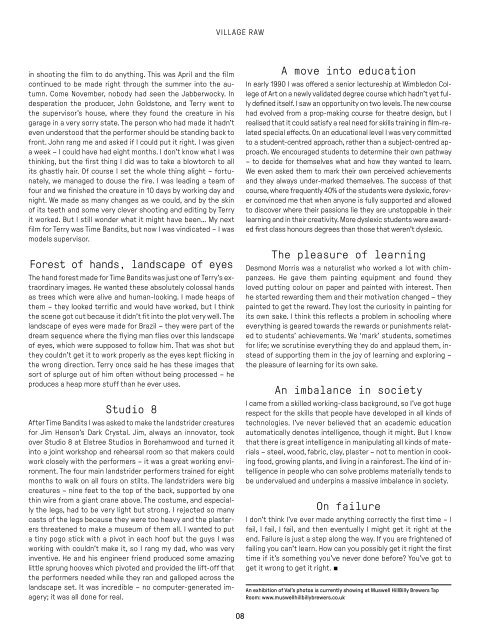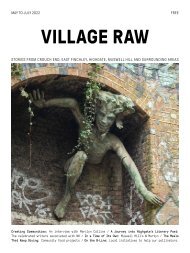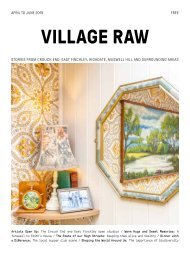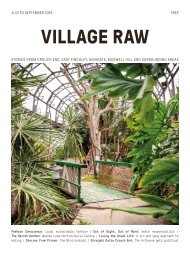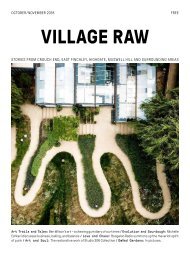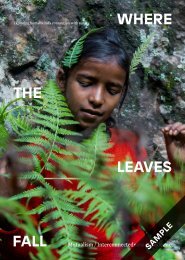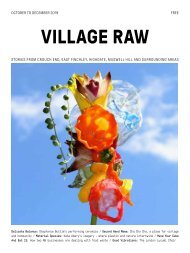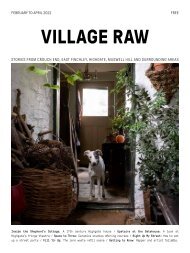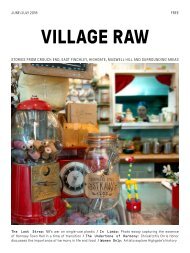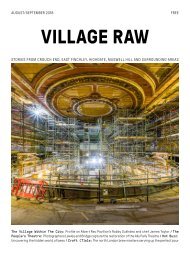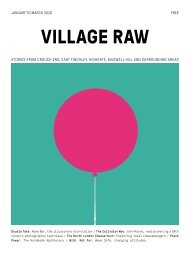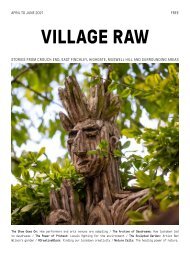Village Raw - ISSUE 4
Village Raw is a magazine that explores cultural stories from Crouch End, East Finchley, Highgate, Muswell Hill and the surrounding areas. The magazine is created by the community, for the community. If you like this issue you can support the project through a subscription or donation. See the links below. The fourth issue of Village Raw magazine includes: THE PYTHONS, A JABBERWOCKY, AND ME - Valerie Charlton on creatures, courses and the need to fail. A LEAP INTO THE UNKNOWN - Artist and dancer Jo Cork’s work with film. SATURN RETURNS - Yazmyn Hendrix - an a cappella artist who sees her music. THE NEXT MEAL - Local initiatives to help the homeless. A NEW ERA FOR HORNSEY TOWN HALL - Looking to the future. A TRUE INDEPENDENT - The Phoenix Cinema is one of the oldest independents in the UK. SECRETS OF A PERSIAN KITCHEN - A collection of recipes has been brewing in Atoosa Sepehr’s home. A TALE OF TWO DISTILLERIES - A look at two local gin-makers bringing mother’s ruin home again. BEYOND THE AISLES - The problem of farm-level food waste. VILLAGE ESSAY - The importance of local government. VILLAGE GREEN - The Guerrilla Gardeners of Palace Gates. AND MORE… Village Raw is created by the community, for the community. If you like this issue you can support the project through a subscription or donation. See the links below.
Village Raw is a magazine that explores cultural stories from Crouch End, East Finchley, Highgate, Muswell Hill and the surrounding areas. The magazine is created by the community, for the community. If you like this issue you can support the project through a subscription or donation. See the links below. The fourth issue of Village Raw magazine includes:
THE PYTHONS, A JABBERWOCKY, AND ME - Valerie Charlton on creatures, courses and the need to fail.
A LEAP INTO THE UNKNOWN - Artist and dancer Jo Cork’s work with film.
SATURN RETURNS - Yazmyn Hendrix - an a cappella artist who sees her music.
THE NEXT MEAL - Local initiatives to help the homeless.
A NEW ERA FOR HORNSEY TOWN HALL - Looking to the future.
A TRUE INDEPENDENT - The Phoenix Cinema is one of the oldest independents in the UK.
SECRETS OF A PERSIAN KITCHEN - A collection of recipes has been brewing in Atoosa Sepehr’s home.
A TALE OF TWO DISTILLERIES - A look at two local gin-makers bringing mother’s ruin home again.
BEYOND THE AISLES - The problem of farm-level food waste.
VILLAGE ESSAY - The importance of local government.
VILLAGE GREEN - The Guerrilla Gardeners of Palace Gates.
AND MORE…
Village Raw is created by the community, for the community. If you like this issue you can support the project through a subscription or donation. See the links below.
Create successful ePaper yourself
Turn your PDF publications into a flip-book with our unique Google optimized e-Paper software.
VILLAGE RAW<br />
ART & CULTURE<br />
in shooting the film to do anything. This was April and the film<br />
continued to be made right through the summer into the autumn.<br />
Come November, nobody had seen the Jabberwocky. In<br />
desperation the producer, John Goldstone, and Terry went to<br />
the supervisor’s house, where they found the creature in his<br />
garage in a very sorry state. The person who had made it hadn’t<br />
even understood that the performer should be standing back to<br />
front. John rang me and asked if I could put it right. I was given<br />
a week – I could have had eight months. I don’t know what I was<br />
thinking, but the first thing I did was to take a blowtorch to all<br />
its ghastly hair. Of course I set the whole thing alight – fortunately,<br />
we managed to douse the fire. I was leading a team of<br />
four and we finished the creature in 10 days by working day and<br />
night. We made as many changes as we could, and by the skin<br />
of its teeth and some very clever shooting and editing by Terry<br />
it worked. But I still wonder what it might have been… My next<br />
film for Terry was Time Bandits, but now I was vindicated – I was<br />
models supervisor.<br />
A move into education<br />
In early 1990 I was offered a senior lectureship at Wimbledon College<br />
of Art on a newly validated degree course which hadn’t yet fully<br />
defined itself. I saw an opportunity on two levels. The new course<br />
had evolved from a prop-making course for theatre design, but I<br />
realised that it could satisfy a real need for skills training in film-related<br />
special effects. On an educational level I was very committed<br />
to a student-centred approach, rather than a subject-centred approach.<br />
We encouraged students to determine their own pathway<br />
– to decide for themselves what and how they wanted to learn.<br />
We even asked them to mark their own perceived achievements<br />
and they always under-marked themselves. The success of that<br />
course, where frequently 40% of the students were dyslexic, forever<br />
convinced me that when anyone is fully supported and allowed<br />
to discover where their passions lie they are unstoppable in their<br />
learning and in their creativity. More dyslexic students were awarded<br />
first class honours degrees than those that weren’t dyslexic.<br />
Forest of hands, landscape of eyes<br />
The hand forest made for Time Bandits was just one of Terry’s extraordinary<br />
images. He wanted these absolutely colossal hands<br />
as trees which were alive and human-looking. I made heaps of<br />
them – they looked terrific and would have worked, but I think<br />
the scene got cut because it didn’t fit into the plot very well. The<br />
landscape of eyes were made for Brazil – they were part of the<br />
dream sequence where the flying man flies over this landscape<br />
of eyes, which were supposed to follow him. That was shot but<br />
they couldn’t get it to work properly as the eyes kept flicking in<br />
the wrong direction. Terry once said he has these images that<br />
sort of splurge out of him often without being processed – he<br />
produces a heap more stuff than he ever uses.<br />
The pleasure of learning<br />
Desmond Morris was a naturalist who worked a lot with chimpanzees.<br />
He gave them painting equipment and found they<br />
loved putting colour on paper and painted with interest. Then<br />
he started rewarding them and their motivation changed – they<br />
painted to get the reward. They lost the curiosity in painting for<br />
its own sake. I think this reflects a problem in schooling where<br />
everything is geared towards the rewards or punishments related<br />
to students’ achievements. We ‘mark’ students, sometimes<br />
for life; we scrutinise everything they do and applaud them, instead<br />
of supporting them in the joy of learning and exploring –<br />
the pleasure of learning for its own sake.<br />
An imbalance in society<br />
Studio 8<br />
After Time Bandits I was asked to make the landstrider creatures<br />
for Jim Henson’s Dark Crystal. Jim, always an innovator, took<br />
over Studio 8 at Elstree Studios in Borehamwood and turned it<br />
into a joint workshop and rehearsal room so that makers could<br />
work closely with the performers – it was a great working environment.<br />
The four main landstrider performers trained for eight<br />
months to walk on all fours on stilts. The landstriders were big<br />
creatures – nine feet to the top of the back, supported by one<br />
thin wire from a giant crane above. The costume, and especially<br />
the legs, had to be very light but strong. I rejected so many<br />
casts of the legs because they were too heavy and the plasterers<br />
threatened to make a museum of them all. I wanted to put<br />
a tiny pogo stick with a pivot in each hoof but the guys I was<br />
working with couldn’t make it, so I rang my dad, who was very<br />
inventive. He and his engineer friend produced some amazing<br />
little sprung hooves which pivoted and provided the lift-off that<br />
the performers needed while they ran and galloped across the<br />
landscape set. It was incredible – no computer-generated imagery;<br />
it was all done for real.<br />
I came from a skilled working-class background, so I’ve got huge<br />
respect for the skills that people have developed in all kinds of<br />
technologies. I’ve never believed that an academic education<br />
automatically denotes intelligence, though it might. But I know<br />
that there is great intelligence in manipulating all kinds of materials<br />
– steel, wood, fabric, clay, plaster – not to mention in cooking<br />
food, growing plants, and living in a rainforest. The kind of intelligence<br />
in people who can solve problems materially tends to<br />
be undervalued and underpins a massive imbalance in society.<br />
On failure<br />
I don’t think I’ve ever made anything correctly the first time – I<br />
fail, I fail, I fail, and then eventually I might get it right at the<br />
end. Failure is just a step along the way. If you are frightened of<br />
failing you can’t learn. How can you possibly get it right the first<br />
time if it’s something you’ve never done before? You’ve got to<br />
get it wrong to get it right. •<br />
An exhibition of Val’s photos is currently showing at Muswell HillBilly Brewers Tap<br />
Room: www.muswellhillbillybrewers.co.uk<br />
PHOTOS COURTESY OF VALERIE CHARLTON. PORTRAIT OF VAL WITH HER MONTY PYTHON BUSTS BY KATE KUZMINOVA<br />
Previous page: Val Charlton with landstrider head at Elstree Studios (The Dark Crystal, 1982); The<br />
Landstriders on set at Elstree Studios (The Dark Crystal, 1982). This Page Clockwise: Val in her studio,<br />
with her Monty Python busts; Jabberwocky creature worn by Peter Salmon on location in Wales (Jabberwocky,<br />
1975); model of the hand forest (Time Bandits, 1981); working on King Arthur’s boat on location in<br />
Scotland (Monty Python And The Holy Grail, 1974).<br />
08<br />
09


